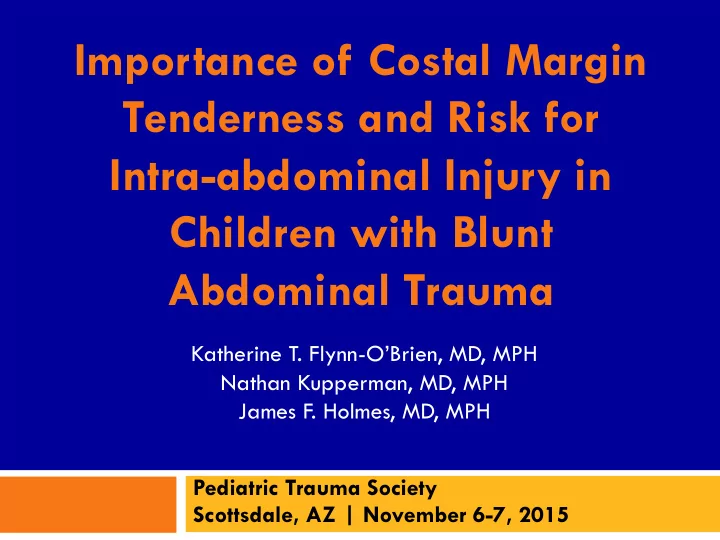

Importance of Costal Margin Tenderness and Risk for Intra-abdominal Injury in Children with Blunt Abdominal Trauma Katherine T. Flynn- O’Brien, MD, MPH Nathan Kupperman, MD, MPH James F. Holmes, MD, MPH Pediatric Trauma Society Scottsdale, AZ | November 6-7, 2015
Disclosures I have no disclosures.
Background Risk of radiation exposure from CT imaging Suspected intra-abdominal injury (IAI) History & physical exam (H&P) findings assist physician’s decision PECARN prediction rule 7 H&P findings to identify children with low risk for IAI Costal margin tenderness (CMT) was not identified as an independent predictor
Background Abdominal wall trauma GCS <14 Vomiting Absent or Abdominal IAI decreased tenderness BS Costal c/o margin Abdominal tenderness pain Thoracic wall trauma
Objective Determine the risk of IAI in 1) children with: Isolated costal margin tenderness (CMT) Non-isolated CMT (+other PECARN) Quantify potentially avoidable CT 2) scans in children with CMT and low risk for IAI
Methods Planned secondary analysis Large prospective multicenter cohort study May 2007-Jan 2010 12,044 children <18 years B lunt torso trauma/”non - trivial” abd trauma 761 children with IAI; 203 IAI with acute intervention Limited to GCS 14-15
Methods Descriptive statistics Comparison of binomial proportions with exact confidence intervals (CI) 2-sided p-value 0.05 or 1-sided p-value 0.025 Relative risk Risk difference
12,044 patients 999 excluded for GCS: enrolled 995 GCS 3-13 4 missing data for GCS 11,045 patients with GCS 14-15 107 missing data for CMT 1,764 excluded due to missing data for PECARN predictors: 9,174 patients with Abd. trauma/seat belt sign (n = 334) data for costal margin Abd. tenderness (n = 558) Thoracic wall trauma (n = 66) tenderness and all C/o abd. pain (n = 1077) PECARN predictor Absent/dec. breath sounds ( n = 195) variables Vomiting (n = 188)
9,174 patients with data for costal margin tenderness and PECARN predictor variables 7,907 without CMT 1,267 CMT 177 isolated CMT 1,090 CMT and 1+ PECARN variables
9,174 patients with data for costal margin tenderness and PECARN predictor variables 7,907 without CMT 1,267 CMT 177 isolated CMT 1,090 CMT and 1+ PECARN variables 4,103 without CMT; but 3,804 without CMT or with 1+ PECARN var. PECARN variables
9,174 patients with data for costal margin tenderness and PECARN predictor variables 7,907 without CMT 1,267 CMT 177 isolated CMT 1,090 CMT and 1+ PECARN variables 4,103 without CMT; but 3,804 without CMT or with 1+ PECARN var. PECARN variables
Results Isolated CMT Non-isolated CMT Demographics Age, years 14 (10, 16) 13 (10, 16) Male 112 (63.3) 712 (65.3) Mechanism of Injury MVC 52 (29.4) 263 (24.1) Ped v. MVC 14 (7.9) 117 (10.9) ATV/scooter 5 (2.8) 55 (5.1) Bicycle 6 (3.4) 86 (7.9) Fall from elev 18 (10.2) 119 (10.9) Fall from stairs 7 (4.0) 10 (1.8) Abd struck 23 (13.0) 206 (18.9)
Results Isolated CMT Non-isolated CMT Other PECARN variables Abdominal trauma n/a 272 (25.0) Abd. tenderness n/a 837 (76.8) Thoracic wall trauma n/a 445 (40.8) C/o abdominal pain n/a 839 (77.0) Absent/dec. BS n/a 56 (5.1) Vomiting n.a 119 (10.9)
Results 1267 with CMT 187 patients with IAI 36 patients with IAI requiring acute intervention
Results: CMT +/- PECARN vars 1267 with CMT 187 patients with IAI 36 patients with IAI requiring acute intervention 1,090 CMT and 1+ 177 isolated CMT PECARN variables 0% 17.2% (15-19.5%) IAI 3.3% (2.3-4.5%) IAI requiring acute intervention
Results: Any IAI (n = 507) No./No. % (95% CI) Relative Risk (95% CI) Isolated CMT 0/177 0.0 (0.0-2.2) -- CMT, 1+ 187/1090 17.2 (15.0-19.5) 16.3 (11.7-22.8) PECARN No CMT, 1+ 280/4103 6.8 (6.1-7.6) 6.5 (4.7-9.0) PECARN No CMT, 40/3804 1.1 (0.8-1.4) Ref no PECARN
Results: IAI acute interv. (n = 113) No./No. % (95% CI) Relative Risk (95% CI) Isolated CMT 0/177 0.0 (0.0-2.2) -- CMT, 1+ 36/1090 3.3 (2.3-4.5) 20.9 (8.8-49.6) PECARN No CMT, 1+ 71/4103 1.7 (1.4-2.2) 11.0 (4.8-25.3) PECARN No CMT, 6/3804 0.2 (0.0-0.3) Ref no PECARN
Results: Risk difference Exposed Unexposed RD = Risk exposed – Cases a b Risk unexposed Non-cases c d CMT + PECARN RD = PECARN var only Risk CMT/PECARN var – Risk PECARN IAI a b variable only No IAI c d
Results: Risk difference Risk e Risk u RD (95 CI%) p-value Abd. trauma 8.3% 3.0% 5% (10,21) 0.297 Abd. tenderness 7.9% 5.1% 3% (-6,12) 0.487 Thoracic wall tr. 3.4% 1.4% 2% (-1,5) 0.063 C/o abd. pain 5.3% 2.5% 3% (-5,10) 0.336 Absent/dec BS 0% 3.4% -3% (-10,3) 0.673 Vomiting 0% 1.8% -2% (-3,-.2) 0.700 Attributable risk of IAI due to CMT = low
Results: CT scan use 3,947 scans of the abdomen & pelvis 40.7% of the population Isolated CMT 36/177 (20.3; 14.6-27.0)
Conclusions Isolated CMT is associated with very low risk of IAI Attributable risk due to CMT for IAI above and beyond other PECARN risk factors is likely minimal In the setting of isolated CMT, abdominal CT scan for evaluation of IAI can likely be avoided
Limitations Missing data Small n, limited power Secondary analysis, increase type I error Generalizability
Thank you Questions? flynnobr@uw.edu
Results N Any IAI IAI req. acute N = 507 intervention No./No. (%; 95% N = 113 CI) No./No. (%; 95% CI) Isolated CMT 177 0/177 (0.0; 0.0-2.2) 0/177 (0.0; 0.0-2.2) CMT and only 1 PECARN var. Abd. trauma 12 1/12 (8.3; 0.2-38.5) 1/12 (8.3; 0.2-38.5) Abd. tenderness 38 3/38 (7.9; 1.7-21.4) 0/38 (0.0; 0.0-9.3) Thoracic wall tr. 119 4/119 (3.4; 0.9-8.4) 1/119 (0.8; 0.0-4.6) C/o abd. pain 38 2/38 (5.3; 0.6-17.7) 0/38 (0.0; 0.0-9.3) Absent/dec BS 5 0/5 (0.0; 0.0-52.2) 0/5 (0.0; 0.0-52.2) Vomiting 8 0/8 (0.0; 0.0-36.9) 0/8 (0.0; 0.0-36.9)
Recommend
More recommend